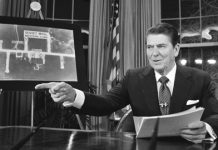On February 21, 1965, Malcolm X, a former Nation of Islam leader, was assassinated by Black Muslims in New York.
Malcolm X Shot Dead in Harlem
Malcolm X was a militant black nationalist leader in the Nation of Islam (NOI) until he left the organization in March 1964 over disputes with NOI leader Elijah Muhammad. In the ensuing year, Malcolm changed the militant philosophy he had espoused, becoming open to peaceful co-existence with whites.
Malcolm frequently received death threats and faced attempts on his life from Nation of Islam members. He knew that his life was in danger, remarking just days before his death, “I’m a marked man. It doesn’t frighten me for myself as long as I felt they would not hurt my family.”
On February 21, 1965, Malcolm X was on stage and about to speak at a rally at the Audubon Ballroom in Harlem, New York, when three members of the Nation of Islam shot him. He was pronounced dead at nearby Columbia Presbyterian Medical Center.
Followers of Malcolm X retaliated against the Black Muslims for the assassination, setting Black Muslim mosques on fire in Harlem and San Francisco.
Nearly 2,000 people attended his funeral on February 27 at the Faith Temple Church of God in Christ in Harlem, where actor Ossie Davis delivered a moving eulogy. He was buried at the Ferncliff Cemetery in Hartsdale, New York.
Malcolm’s killers, Talmadge Hayer, Norman 3X Butler and Thomas 15X Johnson, were convicted of first-degree murder in March 1966.
Related Content
Biography: Malcolm X (1925—65)
Malcolm X was born Malcolm Little in Nebraska on May 19, 1925, into a family of black empowerment advocates in the mold of Marcus Garvey. After his father’s murder and his mother’s nervous breakdown, Malcolm lived in foster homes until he moved in with his half-sister Ella in Boston.
In Boston, Malcolm became involved in crime, earning the nickname “Detroit Red.” In February 1946, he was sent to prison, where he became involved with the NOI, a religious organization led by Elijah Muhammad.
Upon his release in 1952, Malcolm took the name Malcolm X. He traveled the country as a minister and spokesman, establishing new mosques and addressing civil unrest with his characteristic passion and articulate expression, attracting record numbers of new converts.
In contrast to fellow civil rights leader Martin Luther King’s nonviolent approach, Malcolm X promoted an aggressive Nation of Islam separatist doctrine. He talked of the “white devils” and referred to the assassination of President John F. Kennedy as “the chickens coming home to roost.”
As Malcolm rose in the Nation of Islam, he began to clash with Elijah Muhammad over the direction of the organization and who would lead it. Malcolm also became disillusioned with Muhammad after learning that he was secretly having affairs with female followers and had fathered several children. In December 1963, following his comments on Kennedy’s assassination, Malcolm was suspended from the NOI.
Sources in this Story
- The New York Times: Malcolm X Shot to Death at Rally Here
- Time: Death and Transfiguration
- The New York Public Library: Malcolm X: A Search for Truth
- PBS: Malcolm X: Make It Plain
- Colorado State University: Malcolm X—An Islamic Perspective
- The BBC: Misunderstanding Malcolm X
Malcolm X broke with the NOI in March 1964, after the NOI refused to reinstate him even after he convinced boxer Cassius Clay to convert to Islam. He formed his own organization, Muslim Mosque, Inc., and made a religious pilgrimage to Mecca, where he learned that the true teachings of Islam bore little resemblance to the militant teachings of the NOI.
The trip had a profound effect on him, prompting him to change his name to el-Hajj Malik el-Shabazz and re-evaluate his beliefs. He wrote in a letter: “They asked me what about the Hajj had impressed me the most…I said, ‘The brotherhood! The people of all races, color, from all over the world coming together as one!’ It has proved to me the power of the One God…All ate as one, and slept as one. Everything about the pilgrimage atmosphere accented the Oneness of Man under One God.”
Malcolm’s change in philosophy was largely overlooked in the media, and he still had the reputation of a militant at the time of his death. “Unfortunately the image that many…were left with, was of Malcolm as a vengeful militant, a symbol of hatred. Looking back on his life, it’s clear to see there were many Malcolms: Victim, player, prisoner, hater, anti-racist…As a result, Malcolm X is one of the most misunderstood leaders in history,” writes the BBC.
Columbia University’s Malcolm X Project provides an extensive multimedia gallery with audio clips of Malcolm X’s speeches. There’s also video and audio interviews with scholars and activists about Malcolm X, and government documents from the “FBI files of Malcolm X.”











